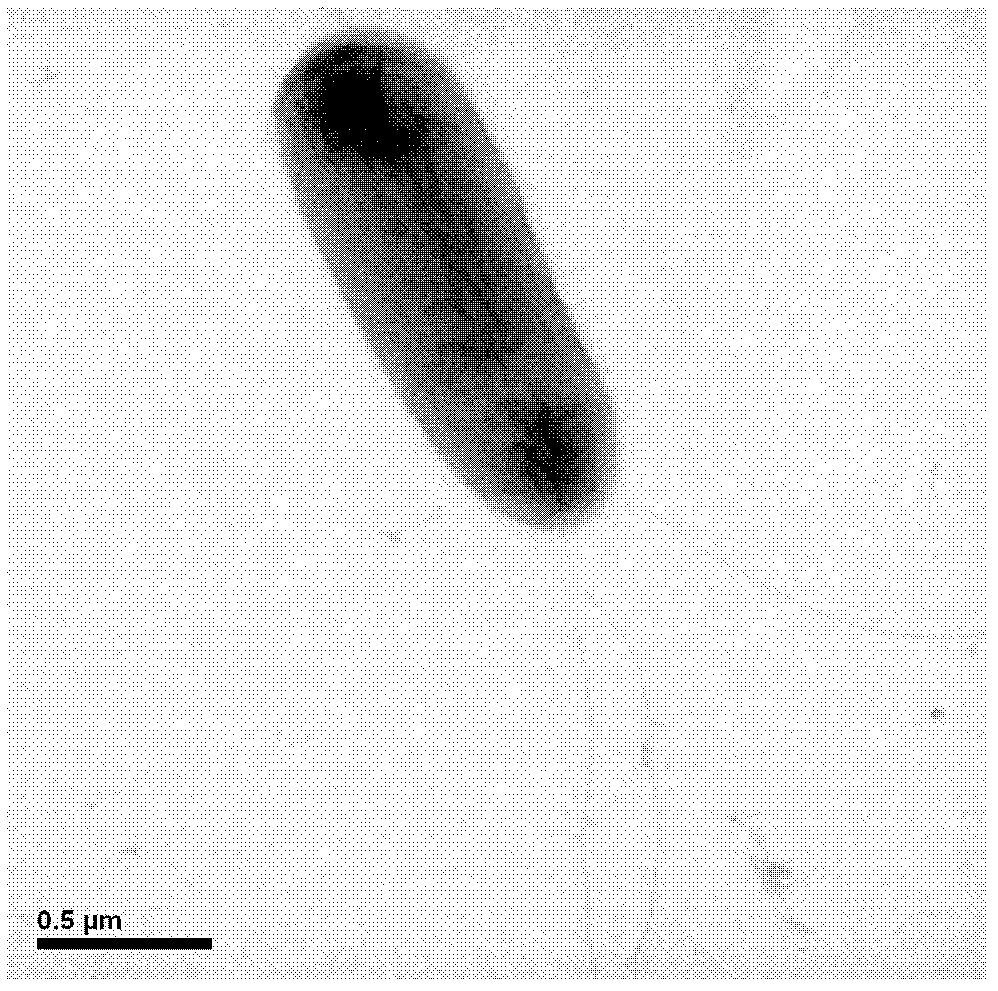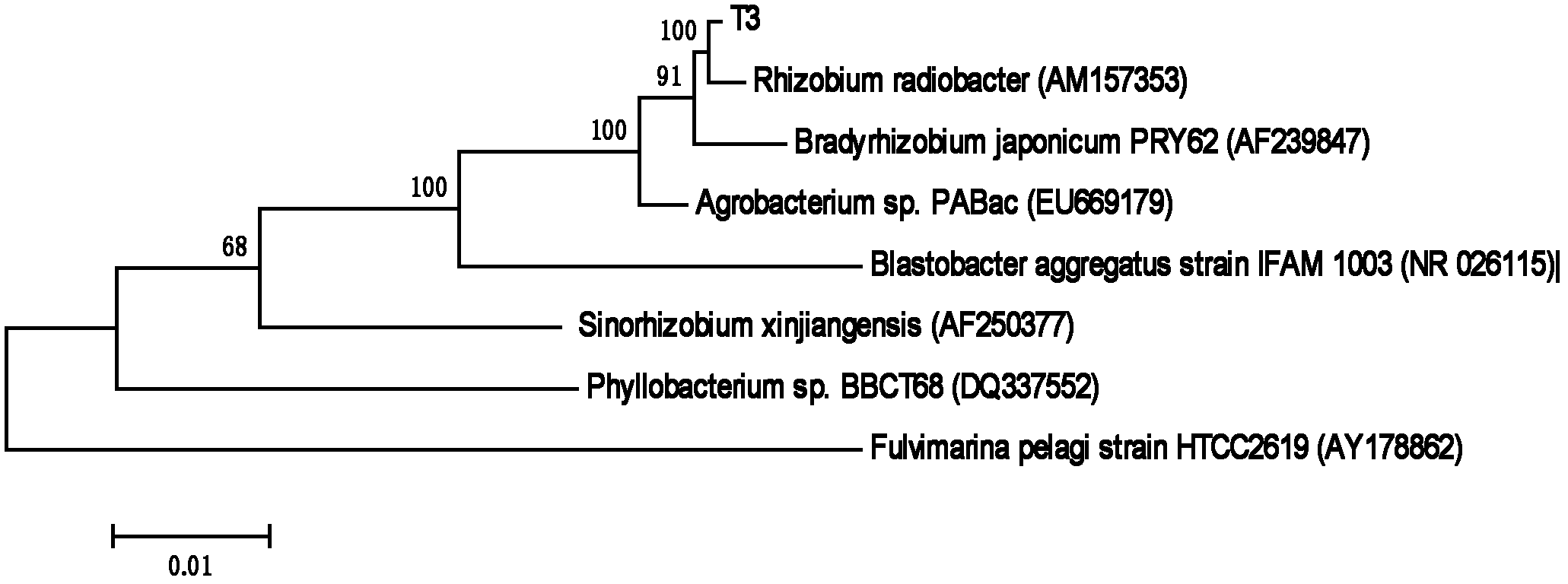Rhizobium sp. T3 and applications thereof in microbial degradation hydrogen sulfide
A technology for microbial degradation and Rhizobium, applied in the direction of microorganism-based methods, microorganisms, biochemical equipment and methods, etc.
- Summary
- Abstract
- Description
- Claims
- Application Information
AI Technical Summary
Problems solved by technology
Method used
Image
Examples
Embodiment 1
[0072] Example 1 Isolation, purification and identification of Rhizobium sp.T3
[0073] The final concentration of the inorganic salt medium of the present invention consists of: sodium thiosulfate 8.0g / L, glucose 0.2g / L, KH 2 PO 4 1.2g / L, K 2 HPO 4 1.2g / L, NH 4 Cl 0.4g / L, MgCl 2 ·6H 2 O 0.2g / L, ferric citrate 0.01g / L, solvent is water, pH 7.0.
[0074] Preparation of agar plate: sodium thiosulfate 8.0g / L, glucose 0.2g / L, KH 2 PO 4 1.2g / L, K 2 HPO 4 1.2g / L, NH 4 Cl 0.4g / L, MgCl 2 ·6H 2 O 0.2g / L, ferric citrate 0.01g / L, solvent is water, pH 7.0, add 15-20g of agar and heat to dissolve.
[0075] 1. Isolation and purification of strain T3
[0076] Rhizobium sp.T3 is a gram-negative bacterium domesticated and isolated from the activated sludge water sample of the wastewater treatment station of Zhejiang Huahai Pharmaceutical Factory. The specific steps are as follows:
[0077] Take 10mL of water samples (10% inoculum size) from the wastewater treatment station o...
Embodiment 2
[0096] Example 2 Rhizobium T3 (Rhizobium sp.T3) to different initial concentrations of H 2 Degradation performance test of S
[0097] (1) Slant culture: Inoculate Rhizobium T3 into the slant medium, cultivate at 30°C for 24 hours, and obtain slant bacteria; the final concentration of the slant medium consists of: yeast powder 5g / L, tryptone 10g / L, chlorine Sodium chloride 10g / L, agar 15g / L, solvent is water, pH value 7.0, sterilized at 121°C for 15min;
[0098] (2) Seed culture: use an inoculation loop to take an inoculation loop from the inclined-plane thalline and inoculate it into the seed medium, cultivate it at 30°C and 160r / min for 2 days, and obtain the seed liquid; the final concentration of the seed medium consists of: yeast powder 5g / L, tryptone 10g / L, sodium chloride 10g / L, agar 15g / L, solvent is water, pH value 7.0, sterilized at 121 ℃ for 15min;
[0099](3) Preparation of bacterial cell suspension: centrifuge the seed liquid at 12000r / min for 10min, discard the ...
Embodiment 3
[0104] Example 3 Rhizobium sp.T3 bacterial strain is to H at different temperatures 2 Degradation properties of S
[0105] (1) Slant culture: inoculate Rhizobium T3 into the slant medium, cultivate at 30° C. for 24 hours to obtain slant bacteria; the final concentration of the slant medium is composed of: yeast extract 5 g / L, tryptone 10 g / L, Sodium chloride 10g / L, agar 15g / L, solvent is water, pH value 7.0, sterilized at 121°C for 15min;
[0106] (2) Seed culture: use an inoculation loop to take an inoculation loop from the inclined-plane thalline and inoculate it into the seed medium, cultivate it at 30°C and 160r / min for 2 days, and obtain the seed liquid; the final concentration of the seed medium consists of: yeast powder 5g / L, tryptone 10g / L, sodium chloride 10g / L, agar 15g / L, solvent is water, pH value 7.0, sterilized at 121°C for 15min;
[0107] (3) Preparation of bacterial cell suspension: centrifuge the seed liquid at 12000r / min for 10min, discard the supernatant, ...
PUM
 Login to View More
Login to View More Abstract
Description
Claims
Application Information
 Login to View More
Login to View More - R&D
- Intellectual Property
- Life Sciences
- Materials
- Tech Scout
- Unparalleled Data Quality
- Higher Quality Content
- 60% Fewer Hallucinations
Browse by: Latest US Patents, China's latest patents, Technical Efficacy Thesaurus, Application Domain, Technology Topic, Popular Technical Reports.
© 2025 PatSnap. All rights reserved.Legal|Privacy policy|Modern Slavery Act Transparency Statement|Sitemap|About US| Contact US: help@patsnap.com



